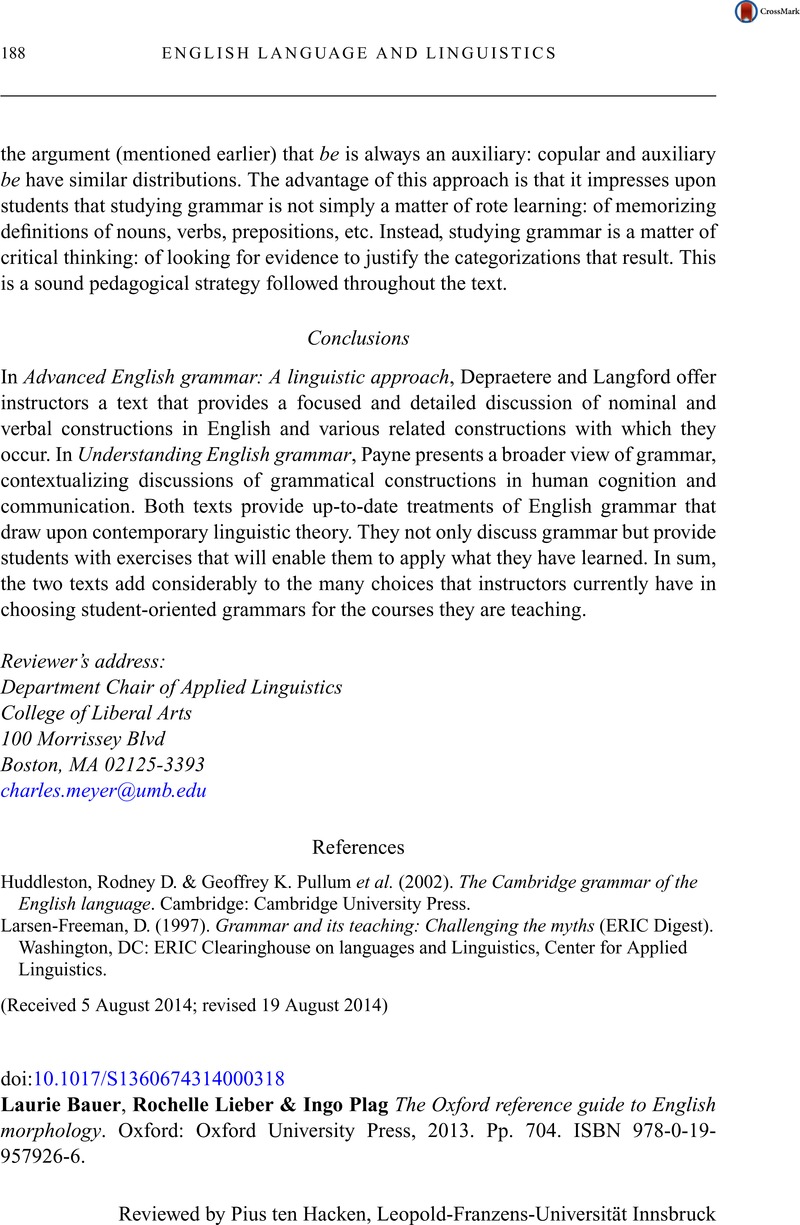No CrossRef data available.
Article contents
Laurie Bauer, Rochelle Lieber & Ingo Plag The Oxford reference guide to English morphology. Oxford: Oxford University Press, 2013. Pp. 704. ISBN 978-0-19-957926-6.
Published online by Cambridge University Press: 26 November 2014
Abstract
An abstract is not available for this content so a preview has been provided. Please use the Get access link above for information on how to access this content.

- Type
- Reviews
- Information
- Copyright
- Copyright © Cambridge University Press 2014
References
Allen, Margaret R. 1978. Morphological investigations. PhD dissertation, University of Connecticut.Google Scholar
Barker, Chris. 1998. Episodic -ee in English: A thematic role constraint on new word formation. Language 74, 695–727.Google Scholar
Chomsky, Noam. 1980. Rules and representations. New York: Columbia University Press.CrossRefGoogle Scholar
COED. 2011. Concise Oxford English dictionary, 12th edn, ed. Stevenson, Angus & Waite, Maurice. Oxford: Oxford University Press.Google Scholar
Davies, Mark. 2008–. The Corpus of Contemporary American English: 450 million words, 1990-present. Available online at http://corpus.byu.edu/coca/.Google Scholar
Fabb, Nigel. 1988. English suffixation is constrained only by selectional restrictions. Natural Language and Linguistic Theory 6, 527–39.CrossRefGoogle Scholar
de Haas, Wim & Trommelen, Mieke. 1993. Morfologisch handboek van het Nederlands: Een overzicht van de woordvorming. The Hague: SDU.Google Scholar
ten Hacken, Pius. 2009. What is a dictionary? A view from Chomskyan linguistics. International Journal of Lexicography 22, 399–421.Google Scholar
ten Hacken, Pius. 2012. In what sense is the OED the definitive record of the English language? In Fjeld, Ruth V. & Torjusen, Julie M. (eds.), Proceedings of the 15th EURALEX International Congress, 834–45. Oslo: Dept of Linguistics.Google Scholar
Hay, Jennifer & Ingo Plag. 2004. What constrains possible suffix combinations? On the interaction of grammatical and processing restrictions in derivational morphology. Natural Language and Linguistic Theory 22, 565–96.Google Scholar
Lees, Robert B. 1960. The grammar of English nominalizations. Bloomington: Indiana University Press and The Hague: Mouton (reissued 1963, 5th printing 1968).Google Scholar
Marchand, Hans. 1969. The categories and types of present-day English word-formation: A synchronic–diachronic approach, 2nd edn.Munich: Beck.Google Scholar
Mühleisen, Susanne. 2010. Heterogeneity in word-formation patterns: A corpus-based analysis of suffixation with -ee and its productivity in English. Amsterdam: John Benjamins.CrossRefGoogle Scholar
OED = Oxford English dictionary, 3rd edn (continuous update), ed. John Simpson. www.oed.com.Google Scholar
Plag, Ingo. 1996. Selectional restrictions in English suffixation revisited: A reply to Fabb (1988). Linguistics 34, 769–98.CrossRefGoogle Scholar
Plag, Ingo. 1999. Morphological productivity: Structural constraints in English derivation. Berlin: Mouton de Gruyter.Google Scholar
Plag, Ingo. 2002. The role of selectional restrictions, phonotactics and parsing in constraining suffix ordering in English. Yearbook of Morphology 200, 285–314.CrossRefGoogle Scholar





